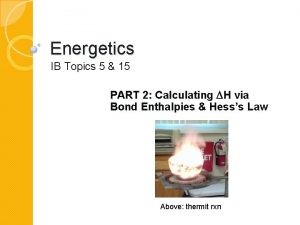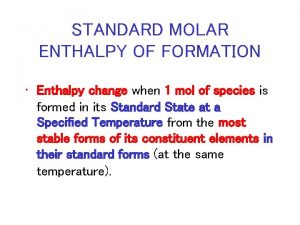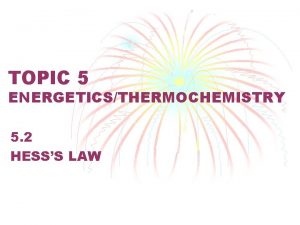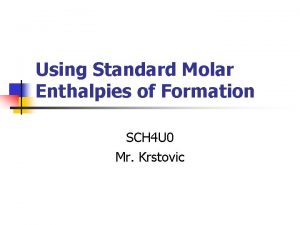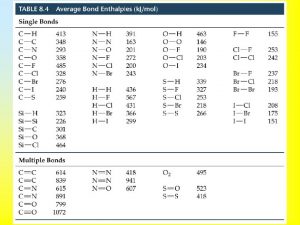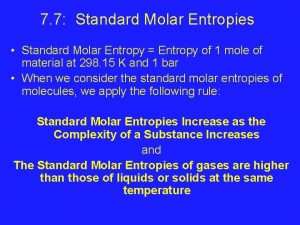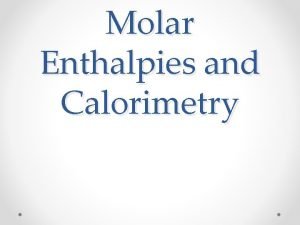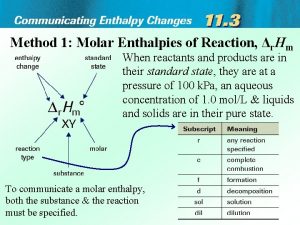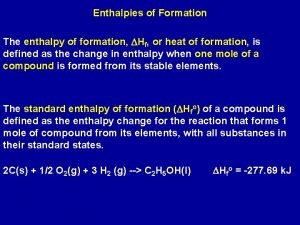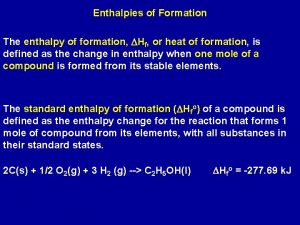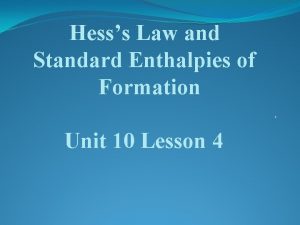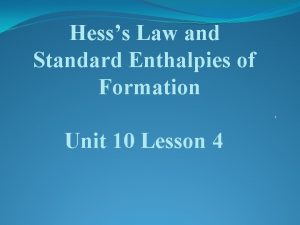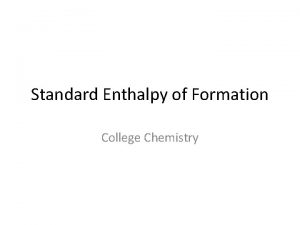Standard Molar Enthalpies of Formation Hf o Focus













- Slides: 13

Standard Molar Enthalpies of Formation ΔHf o

Focus Questions n n n 1) What are formation reactions? 2) What is standard molar enthalpy of formation? 3) How do we write a formation equation? 4) How do we calculate the ∆H using the standard molar enthalpy of formations? 5) How does this method relate to Hess’s Law?

Formation Reactions n n In a formation reaction, a substance is formed from elements in their standard states From what elements is water formed? H 2(g) + ½O 2 (g) H 2 O (l) ΔHfo = -285. 8 k. J The enthalpy change of a formation reaction is called the standard molar enthalpy of formation, ∆H˚f.

Definition of ∆H˚f n The standard molar enthalpy of formation is the quantity of energy that is absorbed or released when one mole of a compound is formed directly from its elements in their standard states.

Formation Equations and ∆H˚f

Note n n The standard enthalpies of formation of most compounds are negative. By definition, the enthalpy of formation of an element in its standard state is zero

Writing a formation equation n n Always write the elements in their standard state (l, g, or s). A formation equation should also show the formation of exactly one mole of the compound of interest.

Calculating Enthalpy Changes n You can calculate the enthalpy change of a chemical reaction by adding the heats of formation of the products and subtracting the heats of formation of the reactants. ∆H˚ = Σ(n∆H˚f products) - Σ(n∆H˚f reactants)

Note n n As usual, you need to begin with a balanced chemical equation. If a given reactant or product has a molar coefficient that is not 1, you need to multiply its ∆H˚f by the same molar coefficient.

Try Solving using Standard enthalpy of formation equation…

How does this method of adding heats of formation relate to Hess’s law? Solve previous question using Hess’s Law…

Note n n It is important to realize that, in most reactions, the reactants do not actually break down into their elements and then react to form products. Since there is extensive data about enthalpies of formation, however, it is useful to calculate the overall enthalpy change this way.

Challenging Question: When octane burns in a car engine, heat is released to the air and to the metal of the engine, but a significant portion is absorb by the liquid in the cooling system -an aqueous solution of ethylene glycol. What mass of octane is completely burned to cause the heating of 20 kg of ethylene glycol from 10 o. C to 70 o. C? Assume water is produced as a gas and that all the heat flows into the coolant. ( ethylene glycol 3. 5 J/go. C)
 Reactants minus products
Reactants minus products Limitations of average bond enthalpies
Limitations of average bond enthalpies Molar enthalpy formula
Molar enthalpy formula Prolepsis
Prolepsis Porter's generic strategies
Porter's generic strategies Cost leadership and differentiation
Cost leadership and differentiation Actor focus vs object focus
Actor focus vs object focus Formation initiale vs formation continue
Formation initiale vs formation continue Application of hess law
Application of hess law Reaction enthalpy
Reaction enthalpy Standard error statistics
Standard error statistics Difference between home language and standard language
Difference between home language and standard language Objectives of standard costing
Objectives of standard costing Kurikulum standard sekolah menengah
Kurikulum standard sekolah menengah

